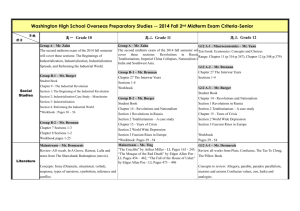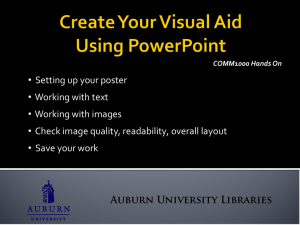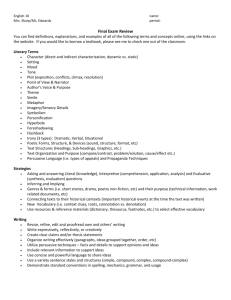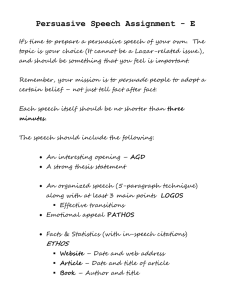Washington High School Overseas Department 2007 First Midterm
advertisement
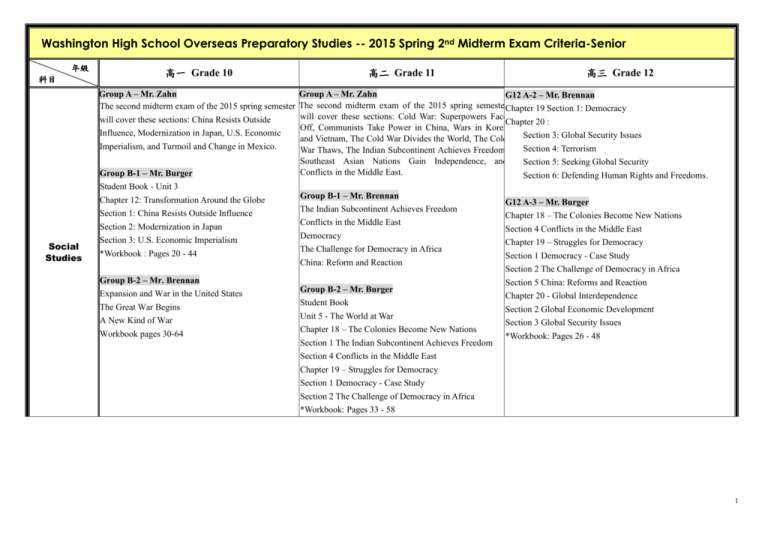
Washington High School Overseas Preparatory Studies -- 2015 Spring 2nd Midterm Exam Criteria-Senior 年級 科目 高一 Grade 10 Group A – Mr. Zahn The second midterm exam of the 2015 spring semester will cover these sections: China Resists Outside Influence, Modernization in Japan, U.S. Economic Imperialism, and Turmoil and Change in Mexico. Social Studies Group B-1 – Mr. Burger Student Book - Unit 3 Chapter 12: Transformation Around the Globe Section 1: China Resists Outside Influence Section 2: Modernization in Japan Section 3: U.S. Economic Imperialism *Workbook : Pages 20 - 44 Group B-2 – Mr. Brennan Expansion and War in the United States The Great War Begins A New Kind of War Workbook pages 30-64 高二 Grade 11 高三 Grade 12 Group A – Mr. Zahn G12 A-2 – Mr. Brennan The second midterm exam of the 2015 spring semesterChapter 19 Section 1: Democracy will cover these sections: Cold War: Superpowers Face Chapter 20 : Off, Communists Take Power in China, Wars in Korea Section 3: Global Security Issues and Vietnam, The Cold War Divides the World, The Cold Section 4: Terrorism War Thaws, The Indian Subcontinent Achieves Freedom, Southeast Asian Nations Gain Independence, and Section 5: Seeking Global Security Conflicts in the Middle East. Section 6: Defending Human Rights and Freedoms. Group B-1 – Mr. Brennan The Indian Subcontinent Achieves Freedom Conflicts in the Middle East Democracy The Challenge for Democracy in Africa China: Reform and Reaction Group B-2 – Mr. Burger Student Book Unit 5 - The World at War Chapter 18 – The Colonies Become New Nations Section 1 The Indian Subcontinent Achieves Freedom Section 4 Conflicts in the Middle East Chapter 19 – Struggles for Democracy G12 A-3 – Mr. Burger Chapter 18 – The Colonies Become New Nations Section 4 Conflicts in the Middle East Chapter 19 – Struggles for Democracy Section 1 Democracy - Case Study Section 2 The Challenge of Democracy in Africa Section 5 China: Reforms and Reaction Chapter 20 - Global Interdependence Section 2 Global Economic Development Section 3 Global Security Issues *Workbook: Pages 26 - 48 Section 1 Democracy - Case Study Section 2 The Challenge of Democracy in Africa *Workbook: Pages 33 - 58 1 Mainstream – Mr. Desmarais -Review all Vocab from: Literature Mainstream – Ms. Ting "To Kill a Mockingbird" by Harper Lee The Californian's Tale, The Balek Scales, Initiation, On the Rainy River and notes from Empire of the Sun - Focus on: symbolism, flashbacks, foreshadowing, Internal and external conflicts, characterization and character motivation, all forms of irony, allusion and charcter foils. - Focus on: setting as symbol, setting as antagonist and setting as theme. 10B-1 – Mr. Boyd Practicing and implementing strategies on the emphasis of creating solid thesis statements for narrative, persuasive and expository paragraphs, Focus on subject verb agreements and grammatically sound sentences emphasizing spelling, Introduce various forms of writing with a focus on process as it relates to organizing, revising, editing, proof reading 10B-2 – Ms. Chen The treasure of Lemon Brown The lady or the Tiger - Vocabulary --Reading comprehension - Short questions - Dynamic and static characters G12 A-1 – Mr. Desmarais The Metamorphosis The Guest Eveline Movie: Synecdoche, NY Review the main features of modern literature and post-modern literature as well as surrealism, existentialism and magical realism. G12 A-2 – Mr. Gill 11B-1 – Mr. Gill Lanchester “Money Talks”, Perkins “Confessions of an Poe “The Raven”, Douglass “Narrative…”, Bierce Economic Hit Man” chapters 1-12 “An Occurrence…” the contents of the book and article -the contents of these readings the aspects of the articles discussed in the homework -the vocabulary on the handouts on these stories questions and in class -the vocabulary highlighted in the book -the literary terms explained in the book in the short answer (25%), longer writing (75%) sections on these stories -the aspects of the stories discussed in the homework questions and in class fill in the blank vocabulary (20%), short answer G12 A-3 – Mr. Dumont vocabulary (5%), short answer readings (30%), Vocabulary - Oedipus the King, Handsomest drowned Man in longer writing on readings (45%) the World 11B-2 – Ms. Chuang Readings/ Multiple Choice - Oedipus the King, Handsomest · understand the main ideas of A Eulogy for Dr. drowned Man in the World, O' Captain My Captain, King Rex Martin Luther King Jr., The Pit and the Pendulum, Film - Dead Poets Society (Long Answer Question) and There Will Come Soft Rains Literary Devices - Symbolism, Theme, Extended Metaphor, · comprehend and identify the literary terms: Dramatic Irony - chronological order Sound Devices - Rhyme, Rhythm, Assonance, Consonance, - rhetorical devices Alliteration - Poe’s style + The Tragic Hero , Magical Realism · demonstrate the understanding of the reading texts: - draw conclusions - paraphrase 2 G10 A Grammar –Ms. Ting G11A: Writing—Mr. Desmarais - Review all persuasive terminology, including: Understanding and Using English Grammar 4th Edition Ch. 17 Adverb Clauses pages 365 - 386 ethos, pathos, logos, claims of truth, claims of Ch. 18 Reduction of Adverb Clauses to Modifying policy, claims of fact, grounds, warrants, Adverbial Phrases pages 387 - 396 objections. - Focus on: qualified, quantified and illustrated G10 A Writing –Ms. Ting statements. Using data, examples, statistics and Persuasive Writing anecdotal information. Critiquing an argument. - Making structured and supported persuasive paragraphs Grammar & Writing 10B-1 Grammar – Ms. Chen Unit 12 - adjective clauses - fill in the blank - rewrite the sentences -Review the quiz paper / TOEFL VOCAB -Exercise in the textbook -paragraph writing 12 A-1 Writing – Mr. Desmarais Review Logical Fallacies All features writing covered in grade 12 Writing about Ethical Issues 12A-2 Writing – Mr. Armstrong Students will be given various writing prompts which will test their writing abilities in all areas we have covered in their final year. 11B-1 Writing – Mr. Armstrong Student's will be given persuasive writing 12A-3 Writing – Mr. Gill prompts; they must choose one and respond to it Writing book, units 5,6 in an appropriate way with a short persuasive writing argument and reaction/response essays essay. They must show an understanding of the short answer (10%), 2 essays (90%) art of persuasion and must execute the techniques they have learned in both this and last semester. 10B-1Writing – Mr. Dumount Vocabulary of Persuasion Short Answer Writing - Ethos, Logos & Pathos Appeals Claims, Grounds, Warrants and the art of debate Persuasive Essay Content & Structure (diagram) The Counterclaim (From last persuasive writing term) 3 10B-2 Grammar – Mr. Lu 11B-2 Writing – Ms. Chuang · recognizing word forms and common suffixes · forming the comparative and superlative of Advice, Necessity, Requests and Suggestions adjectives and adverbs • The use of the model auxiliaries( can, could, · parallel structure may, might, must, should, will, would, be able to, be · organization of a comparison essay • Ch12 & Ch 13 Models, Expressing Ability, going to, have/has to and had to) • Test includes choose the correct answer, edit the sentences, read and answer the questions, fill in the blanks and write an essay 10B-2 Writing – Mr. Boyd Practicing and implementing strategies on the emphasis of creating solid thesis statements for narrative, persuasive and expository paragraphs, Focus on subject verb agreements and grammatically sound sentences emphasizing spelling, Introduce various forms of writing with a focus on process as it relates to organizing, revising, editing, proof reading 4 Group A – Mr. Willemse Group A – Mr. Willemse Group A – Mr. Willemse Polynomial Functions 4.1-4.9 Radical and Rational Functions Exponential Functions 6.1-6.2 Probabilities and Statistics 12.1-12.3 Matrices 10.1-10.4 Parametric Equations 9.7 Polynomials 3.2 The exam covers all course material covered for the 1st and 2nd Semester from Chapter 1.1 to 7.2 5.1-5.6 Group 10B-1- Mr. Steele 7.4 Inverse Functions 8.1 to 8.6 Exponents and Logarithms 9.2 Simple Rational Functions Math Group 10B-3 – Mr. Rocheleau 7.4 Inverse Functions 7.5 Graphing Square Root and Cube Root Functions 8.1 Exponential Growth 8.2 Exponential Decay 8.3 The Number e 8.4 Logarithmic Functions 8.5 Properties of Logarithms 8.6 Solving Exponential and Logarithmic Equations (and Inequalities) 9.2 Graphing Simple Rational Functions Group B-1 – Mr. Steele 7.4 Inverse Functions 8.1 to 8.6 Exponents and Logarithms 9.2 Simple Rational Functions Group B-1 – Mr. Steele 8.4 to 8.6 Vectors 12.1 to 12.3 Sets and Probability 10.1 to 10.3 Matrices Group B-3 – Ms. Chen Factoring high order polynomial Group B-3 – Mr. Rocheleau Rational Function 7.4 Inverse Functions - finding zeros 7.5 Graphing Square Root and Cube Root Functions - finding VA and HA 8.1 Exponential Growth - state the domain 8.2 Exponential Decay - sketching the function 8.3 The Number e 8.4 Logarithmic Functions 8.5 Properties of Logarithms 8.6 Solving Exponential and Logarithmic Equations (and Inequalities) 9.2 Graphing Simple Rational Functions 5 G10 Biology-- Mr. Rocheleau DNA 12.1 Identifying the Substance of Genes 12.2 The Structure of DNA 12.3 DNA Replication RNA and Protein Synthesis 13.1 RNA 13.2 Ribosomes and Protein Synthesis 13.3 Mutations Darwin’s Theory of Evolution 16.1 Darwin’s Voyage of Discovery 16.2 Ideas That Shaped Darwin's Thinking 16.3 Darwin Presents His Case 16.4 Evidence of Evolution Science 10B Physics – Mr. Backus Electrostatics 32.1 to 32.7 Electric Fields and Potential 33.1 to 33.7 G11 Biology – Mr. Rocheleau Digestive and Excretory Systems 30.1 Organization of the Human Body 30.2 Food and Nutrition 30.3 The Digestive System 30.4 The Excretory System 12B Chemistry – Mr. C. Willemse Ions in Aqueous Solutions and Colligative Properties Nervous System 31.1 The Neuron 31.2 The Central Nervous System 31.3 The Peripheral Nervous System 31.4 The Senses Lab 3: Sensory Perception 12B Physics – Mr. Backus Color Reflection and Refraction Temperature, Heat, and Expansion Skeletal, Muscular, and Integumentary Systems 32.1 The Skeletal System 32.2 The Muscular System 32.3 Skin - The Integumentary System 11B Chemistry – Mr. C. Willemse Nuclear Chemistry Acids and Bases Acid-Base Titration and pH G12 AP Bio. & MOOC – Mr. C. Willemse According to their process Electric Current 34.1 to 34.11 Organic Chemistry 10B Chemistry -_ Mr. C. Willemse Nuclear Chemistry Biological Chemistry Organic Chemistry Biological Chemistry 11B Physics – Mr. Backus Electrostatics 32.1 to 32.7 Electric Fields and Potential 33.1 to 33.7 Electric Current 34.1 to 34.11 Microeconomics: • • • • Review Chapter 7 – Lesson 7.1, 7.2, 7.3 & 7.4. Review Workbook - Key Terms (vocabulary), Review questions and Key concepts Summary Review Reading Study Guide and Quizzes. The exam will be a mix of Vocabulary Matching, Multiple Choice, Short Answer, Essay questions and a case study. 6 Macroeconomics: Chapter 15: Using fiscal policy 15.1: What is fiscal policy? 15.2: Demand-side and supply-side policies 15.3: Deficits and the national debt Chapter 16: The Federal Reserve and monetary policy 16.1: The Federal Reserve System 16.2: Functions of the Federal Reserve 16.3: Monetary policy 16.4: Applying monetary and fiscal policy G12 Introduction to management- Mr. Mclsaac • • • Review handout on Leadership (Chapter 12) making sure that you review the lecture notes that you have taken. The exam questions will deal with the theories we have discussed. Primary source documents may be a part of the exam, along with short answer and multiple choice questions. G12 Introduction to management- Mr. Yuan Chapter 11: Mastering the Meeting. Chapter 12: Improving Performance. G12 Chemistry II Ions in Aqueous Solutions and Colligative Properties 13.1 Compounds in Aqueous Solutions 13.2 Colligative Properties of Solutions Acids and Bases 14.1 Properties of Acids and Bases 14.2 Acid-Base Theories 7 14.3 Acid-Base Reactions Lab 4: Acid and Base Properties Acid-Base Titration and pH 15.1 Aqueous Solutions and the Concept of pH 15.2 Determining pH and Titrations Lab 5: Titration Lab Psychology G12 Unit 5: Personality Chapter 13 – Motivation and Emotion Section 1 – Psychology of Motivation Section 2 – Biological Needs: Focus on Hunger Section 3 – Psychological Needs Section 4 – Emotions Workbook: Pages 74 - 87 8

